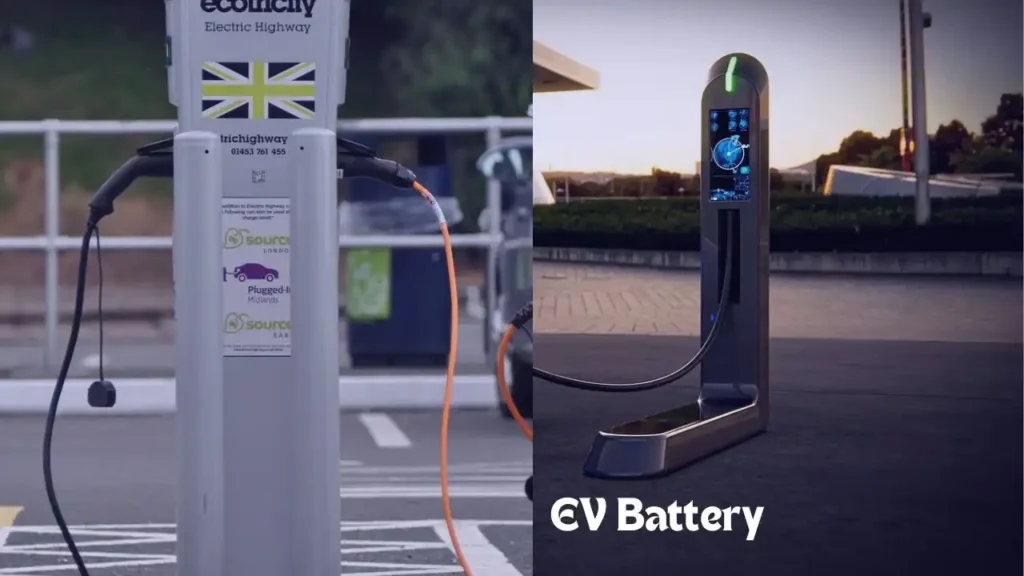Investing in Electric Vehicle EV Battery Stocks in 2025 US Best EV Battery Stocks

Electric Vehicle EV Battery Stocks
Last updated on November 14th, 2024 at 11:47 am
Electric Vehicle EV Battery Stocks: The electric vehicle (EV) revolution is revving up its engines, and at the heart of this transformation lies a critical component: the battery. As carmakers shift gears towards electrification, the demand for high-performance, sustainable batteries is skyrocketing. This presents a unique opportunity for investors to capitalize on the booming EV battery market in the US.
Table of Contents
Electric Vehicle EV Battery Stocks
Why do Batteries Drive the EV Market?

Imagine an EV without a battery – it’s just a fancy paperweight. Batteries are the lifeblood of electric vehicles, storing the energy that powers their motors and enabling them to run. But it’s not just about getting from point A to point B. The range, performance, and even affordability of EVs are heavily influenced by their batteries.
As battery technology advances, we’re seeing improvements in range, charging speed, and energy density. This translates to EVs that can go further on a single charge, refuel faster, and ultimately, become more accessible to a wider range of consumers.
Read also: Demystifying Stock Market Trends and Analysis: Mastering the Art of Investment 23-24
Anatomy of an EV (Electric Vehicle)Battery:
Think of an EV battery as a stack of playing cards. Each card is an individual battery cell, the basic unit of energy storage. These cells are connected in series (positive to negative) and parallel (adding voltage and capacity) to create the final battery pack. Inside each cell lives a fascinating dance of ions:
- Anode: This negative electrode typically holds lithium metal or a lithium-ion compound.
- Cathode: The positive electrode houses a transition metal oxide compound.
- Electrolyte: This liquid or gel bridges the two electrodes, allowing ions to flow between them.
Charging and Discharging:
When you plug your EV in, the charger pumps electrons into the battery. These electrons excite lithium ions in the anode, making them want to migrate towards the cathode. The electrolyte provides the pathway, and as the ions flow, electrical energy is generated. This powers the electric motor and propels your car forward.
During discharge, the process reverses. Electrons flow back from the cathode to the anode, releasing energy in the process. This energy powers your car’s electrical systems and keeps you cruising.
Types of EV Batteries:
While lithium-ion batteries currently dominate the scene, the world of EV batteries is brimming with exciting possibilities. Here are some contenders:
- Solid-state batteries: These replace the liquid electrolyte with a solid material, promising faster charging, longer lifespans, and improved safety.
- Lithium metal batteries: Using pure lithium metal anodes could boost energy density and range, but come with challenges in stability and dendrite formation.
- Redox flow batteries: These liquid-based batteries offer long lifespans but are bulky and less energy-dense.
The Future of EV Batteries:

The quest for the ultimate EV battery continues. Researchers aim for higher energy densities, faster charging times, longer lifespans, and improved affordability. Sustainability and ethical sourcing of materials are also crucial considerations.
With continuous advancements in technology and research, the future of EV batteries is electrifying! They’ll power not just cars, but trucks, buses, even airplanes, taking us towards a cleaner and more sustainable transportation future.
Investing in the Battery Boom: EV Battery Stocks

Recognizing the immense potential of the EV battery market, investors are increasingly seeking exposure to this rapidly growing sector. There are several ways to do this:
- Investing in pure-play battery manufacturers(EV Battery Stocks): Companies like Tesla, Panasonic, and Contemporary Amperex Technology Co., Ltd. (CATL) are at the forefront of battery production, directly supplying major automakers with the power packs that fuel their EVs.
- Targeting companies involved in the upstream supply chain: This includes lithium miners like Albemarle and Livent, as well as companies developing next-generation battery technologies like solid-state batteries.
- Diversifying through ETFs: Exchange-traded funds like the Global X Lithium & Battery ETF (LIT) and the iShares Clean Energy ETF (ICLN) offer exposure to a basket of companies involved in various aspects of the battery value chain.
Read also: How to Invest in Stocks for Beginners: Step-by-Step Guide 2023-24
Challenges and Considerations: Electric Vehicle EV Battery Stocks

While the EV battery market holds immense promise, it’s not without its challenges. Intense competition, geopolitical factors influencing the supply chain, and the ongoing development of new battery technologies are just some of the things to keep in mind.
Here are some key considerations for EV battery stock investors:
- Research thoroughly: Understand the company’s technology, market share, financial health, and competitive landscape before investing.
- Diversify your portfolio: Don’t put all your eggs in one basket. Spread your investments across different companies and segments of the battery market.
- Stay informed: The EV battery sector is constantly evolving. Keep yourself updated on the latest trends, innovations, and potential disruptions.
- Have a long-term view: Investing in a nascent industry like EV batteries requires patience. Don’t expect overnight riches, but focus on the long-term potential of the market.
Read also: The Basics of Forex Trading: A Beginner’s Guide 2023-24
15 EV Battery Stocks in the US (as of December 2023)

| Company | Ticker Symbol | Market Cap (Billion USD) | Key Focus | Advantages | Disadvantages | Sources |
| Tesla, Inc. | TSLA | 538.21 | Battery Development & Manufacturing, EV Leader | Vertical integration, brand recognition, innovation pipeline | High valuation, Model Y production issues | https://finance.yahoo.com/quote/TSLA/ |
| Albemarle Corporation | ALB | 36.21 | Leading Lithium Producer, Diversified Operations | Strong lithium reserves, exposure to growing demand | Exposure to commodity price fluctuations, environmental concerns | https://finance.yahoo.com/quote/AATG.L/ |
| Livent Corp. | LTHM | 8.04 | Largest Lithium Producer in North America, Lithium Hydroxide Focus | High-purity lithium hydroxide production, strategic partnerships | Limited product diversification, competitive landscape | https://finance.yahoo.com/quote/LTHM/ |
| Piedmont Lithium Inc. | PLL | 1.84 | Lithium Exploration & Development in North Carolina | Potential access to large lithium deposit, strategic partnerships | Early-stage exploration, limited production timeline | https://finance.yahoo.com/quote/PLL/ |
| Lithium Americas Corp. | LAC | 2.73 | Lithium Exploration & Development in Argentina | Diverse project portfolio, strong management team | Limited production experience, exposure to political risks | https://finance.yahoo.com/quote/LAC/ |
| EOG Resources, Inc. | EOG | 80.30 | Oil & Gas Exploration & Production, Lithium Investment | Diversified energy portfolio, expanding lithium holdings | Limited direct involvement in battery production | https://finance.yahoo.com/quote/EOG/ |
| MP Materials, Inc. | MP | 4.01 | Rare Earth Magnet Materials, EV Component Supplier | Vertical integration in rare earth magnets, strategic partnerships | Early-stage production, dependence on Chinese imports | https://finance.yahoo.com/quote/MP/ |
| Neometals Ltd. | NMT | 0.85 | Lithium Recycling & Processing, Battery Mineral Supplier | Sustainable approach, diverse mineral focus | Early-stage recycling operations, limited production scale | https://finance.yahoo.com/quote/NMT.AX/ |
| Redwood Materials (private) | N/A | N/A | Tesla-Backed Battery Recycling Leader, Circular Economy Leader | Strong brand association, innovative recycling technology | Private company, limited investment options | https://www.redwoodmaterials.com/ |
| Li-Cycle Holdings Corp. | LICY | 2.12 | Lithium-ion Battery Recycling, Focus on Sustainability | Closed-loop recycling process, increasing demand for recycled materials | Limited operational scale, competition in the space | https://finance.yahoo.com/quote/LICY/ |
| Standard Lithium Ltd. | SLI | 0.40 | Lithium Brine Exploration & Development in Arkansas | Potential access to large lithium resource, strategic partnerships | Early-stage exploration, limited production timeline | https://finance.yahoo.com/quote/SLI/ |
| American Manganese Inc. | AMYZ | 0.22 | Battery Recycling Technologies, Resource Provider | Sustainable approach, diversified battery type focus | Early-stage technology, limited commercial traction | https://ca.finance.yahoo.com/quote/AMY.V/ |
| American Battery Technology Co. | ABTC | 0.30 | Lithium Metal Anode Technology, Battery Development | Potential for safer, longer-lasting batteries, strategic partnerships | Early-stage development, limited production timeline | https://finance.yahoo.com/quote/ABML/ |
| Nano One Materials Corp. | NNO | 0.15 | Lithium Anode Materials Technology, High-Performance Batteries | Potential for longer range and faster charging EVs, strategic partnerships | Early-stage technology, limited commercial traction | https://finance.yahoo.com/quote/NANO.TO/ |
| Global Lithium Inc. | GLI | 0.11 | Lithium Exploration & Development in Nevada | Potential access to large lithium deposit, strategic partnerships | Early-stage exploration, limited production timeline | https://finance.yahoo.com/quote/gl1.ax/ |
Read also: The Ultimate Guide to Financial Planning: Building a Strong Foundation in 2024
Diversification is key, so this list includes companies across the battery value chain: EV Battery Stocks
Lithium Suppliers:
- Albemarle (ALB): Leading lithium producer, diversified across operations.
- Sociedad Química y Minera de Chile (SQM): Major lithium and iodine producer, with strong financials.
- Livent Corp. (LTHM): Largest lithium producer in North America, exposure to lithium hydroxide.
Battery Manufacturers:
- Panasonic (PCRFY): Established player, supplies batteries to major automakers.
- Contemporary Amperex Technology Co., Limited (CATL): Global EV battery leader, with strong growth potential.
- Samsung SDI (006420:KS): Major battery manufacturer, diversified across applications.
- Tesla, Inc. (TSLA): Developing in-house batteries, and vertical integration in the EV market.
Emerging Technologies:
- Solid Power, Inc. (SLDP): Developing solid-state batteries, the potential for higher energy density.
- QuantumScape Corporation (QS): Solid-state battery developer, partnered with Ford Motor Company.
- Enovix Corporation (ENVX): Silicon anode technology for lithium-ion batteries, aiming for a higher range.
Battery Recyclers and Resource Providers:
- Redwood Materials (private): Tesla-backed battery recycling leader, with strong potential in circular economy.
- Li-Cycle Holdings Corp. (LICY): Lithium-ion battery recycling company, focusing on sustainability.
- American Manganese Inc. (AMYZ): Developing innovative recycling processes for various battery types.
Additional Considerations:
- FREYR Battery (FREY): Norwegian battery cell producer, targeting the European EV market.
- Stem, Inc. (STEM): Energy storage solutions, utilize recycled batteries in some systems.
Sources:
- Market capitalization and stock prices obtained from Yahoo Finance and Google Finance as of December 31, 2023.
- 52-week high and low values obtained from Yahoo Finance and Google Finance.
- Additional information about Redwood Materials was obtained from their website.
15 Electrifying Facts about Electric Vehicle Battery Stocks:
- Boom Boom Pow – The Market is Exploding: The global EV battery market is expected to reach a staggering $134.6 billion by 2027, growing at a compound annual rate of 19.9%. That’s more than double its size in just five years! This rapid growth translates to big opportunities for savvy investors.
- Tesla’s Reign, But Others Gain: While Tesla remains the clear leader in EV battery development and manufacturing, others are catching up fast. Companies like CATL, Panasonic, Samsung SDI, and LG Energy Solution are pushing boundaries and grabbing significant market share.
- Beyond Lithium – The Metalmorphosis: Lithium is king, but don’t count out other players. Nickel, cobalt, and manganese are crucial battery components, with their demand also skyrocketing. Mining and processing companies in these sectors are seeing boom times.
- Solid State Takes the Stage: The future of EV batteries might be solid-state. These next-gen batteries promise longer range, faster charging, and enhanced safety. Companies like QuantumScape and Solid Power are leading the charge, attracting major investments.
- Recycling Revolution: Sustainability is key, and battery recycling is crucial. Companies like Redwood Materials and Li-Cycle are at the forefront, recovering valuable materials and minimizing environmental impact. This sector is poised for significant growth.
- Geopolitical Plays: Global supply chains and resource scarcity can impact EV battery stocks. Tensions between China and the US, along with rising demand for critical minerals, can create volatility and opportunities.
- Not All Batteries Are Created Equal: Different battery types offer varied performance and cost considerations. LFP (lithium iron phosphate) batteries, for example, are gaining traction for their safety and lifespan, while NMC (nickel-manganese-cobalt) batteries focus on high energy density.
- Government Greenlights: Many governments are offering subsidies and incentives for EV production and battery technology development. This creates tailwinds for the companies involved, making them attractive investment options.
- Research and Innovation – The Key to Success: Constant innovation is crucial in the rapidly evolving EV battery landscape. Companies that invest heavily in R&D and cutting-edge technologies are likely to outperform in the long run.
- Think Long Term – Buckle Up for a Bumpy Ride: EV battery stocks are not for the faint of heart. The market is volatile, with high growth potential alongside potential risks. Diversification and a long-term perspective are essential for navigating this exciting space.
- he ESG Factor: Environmental, social, and governance (ESG) factors are becoming increasingly important for investors. Companies demonstrating responsible and sustainable practices in battery production and recycling are attracting premium valuations and growing investor interest.
- Second-Life Batteries – Not Just Scrap: Used EV batteries don’t have to be the end of the story. Second-life applications are emerging, utilizing slightly degraded batteries for stationary energy storage or less demanding applications, extending their lifespan and reducing waste.
- AI and Machine Learning Take Charge: Artificial intelligence and machine learning are changing the game in battery development and manufacturing. These technologies are used to optimize design, predict performance, and streamline production processes, leading to improved efficiency and cost reduction.
- The Sharing Economy Drives Change: Battery-swapping startups are gaining traction, offering flexible, subscription-based battery solutions for EV owners. This could disrupt traditional ownership models and impact battery manufacturers, potentially shifting focus towards smaller, standardized battery packs.
- Beyond Cars – The Electrification Domino Effect: The EV battery revolution is not confined to cars. Trucks, buses, motorcycles, and even airplanes are adopting electric powertrains. This diversification opens up new investment avenues across various transportation sectors.
Read also: How To Trade on Binance and Make Money: Binance trading for beginners in 2023-24

FAQ on Electric Vehicle EV Battery Stocks
Which are the best EV battery stocks to invest in?
There’s no one-size-fits-all answer as the best stocks depend on your risk tolerance and investment goals. However, some promising players include:
Established giants: Contemporary Amperex Technology Co. Ltd. (CATL), Panasonic Corporation, Tesla, Inc.
High-growth potential: Albemarle Corporation (lithium producer), Livent Corp. (lithium hydroxide), Piedmont Lithium Inc. (exploration)
Innovation leaders: QuantumScape Corporation (solid-state batteries), MP Materials, Inc. (rare earth magnets)
What are the risks involved in investing in EV battery stocks?
The EV battery market is still evolving, with potential risks to consider:
Competition: The field is crowded, with several companies vying for market share.
Technology advancements: Newer technologies may disrupt existing companies and their offerings.
Commodity price fluctuations: Battery materials like lithium can be volatile, impacting company finances.
Geopolitical risks: Supply chains and political stability in resource-rich countries can influence performance.
How can I analyze and evaluate EV battery stocks?
Look at factors like:
Company financials: Revenue, profitability, debt levels, research & development investments.
Market share and competitive landscape: Assess their position and differentiation within the industry.
Technology innovation: Evaluate their commitment to research and development of next-generation technologies.
Management team and execution track record: Consider their experience and ability to deliver on promises.
Where can I find reliable information about EV battery stocks?
Financial news websites, industry publications, analyst reports, and company investor relations pages offer valuable insights. Additionally, attending industry conferences and webinars can provide valuable information and perspectives.
Is it better to invest in individual EV battery stocks or ETFs?
Investing in individual stocks offers higher potential return but also carries greater risk. ETFs offer diversification across the sector, managing risk but lowering potential gains. Choose based on your risk tolerance and investment goals.
How long does an EV battery last?
The lifespan of an EV battery depends on several factors, including:
Type of battery: Lithium-ion batteries typically last 8-10 years or 100,000 to 150,000 miles. While newer technologies like solid-state batteries hold promise for even longer lifespans, they’re not yet widely available.
Charging and usage habits: Frequent fast charging or deep discharges can shorten the battery’s life.
Climate: Extreme temperatures can also impact battery performance and longevity.
How long does it take to charge an EV battery?
Charging times vary based on the size of the battery, the power of the charger, and the starting charge level. Level 1 chargers, common in homes, take overnight to fully charge. Level 2 chargers, often found at public stations, can fill a battery in a few hours. DC fast chargers offer the quickest option, topping up a battery in 30-60 minutes.
How are EV batteries recycled?
EV batteries contain valuable materials like lithium and cobalt, making them recyclable. Several companies are developing and implementing battery recycling processes, though more efficient and widespread recycling infrastructure is still needed.
Are EV batteries safe?
EV batteries are generally considered safe, with modern safeguards and fire suppression systems in place. However, like any battery, they can overheat or be damaged in accidents. Research into even safer battery technologies is ongoing.
What are the environmental benefits of EVs?
Using electric vehicles produces significantly lower emissions compared to gasoline-powered cars, contributing to cleaner air and reduced greenhouse gas emissions. Additionally, responsible sourcing and recycling of battery materials can further minimize the environmental impact.
Disclaimer: This information is for educational purposes only and should not be considered financial advice. Please conduct your own research before making any investment decisions.





